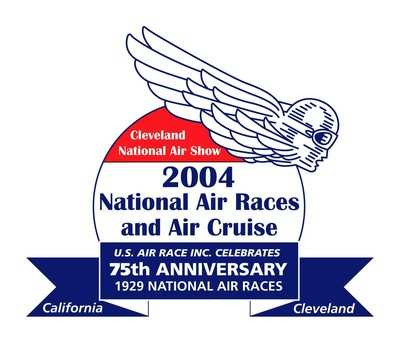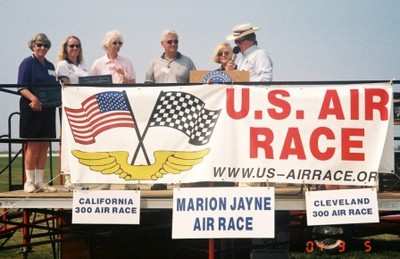Race Marks 75th Diamond Jubilee of the 1929 National Air
Races
General Aviation made TV, radio and newspaper headlines across
the country for all the right reasons as pilots demonstrated their
skills in 3 cross country speed races that marked the 75th
Anniversary of the National Air Races.

"Honor the Past. Invest in the Future" was the theme as $20,000
in cash, Jeppesen software and six scholarships were awarded. Teams
were newsworthy because they enhanced the perfect safety record to
over 457,000 safe race miles (about 18 times around the world) and
over 3,000 happy landings. They brought positive press to every
airport along the 2100-mile Marion Jayne California to Cleveland
and the two 300-mile race routes. Awards were made at the
TFR-delayed Cleveland National Air Show Center by Cleveland
Convention & Visitors Bureau President, Dennis Roche and US Air
Race President, Patricia Jayne Keefer.
Newly minted Grand Champions Shelby Bowles and Jim Reed are
typical of the pilots that competed in the National Air Races as
both make their livings outside of aviation and they made no
special modifications to Bowles’ Cessna Skymaster "Wild
Thing" for the races other than taking the bugs off. Aircraft are
equalized with handicaps. Bowles is a former Marine and funds his
flying as a financial advisor. Reed is a retired engineer and
part-time air show performer. Both men are from Maryland. Racing as
team #41, they won the Marion Jayne Perpetual Trophy with their
performance across all three US Air Race events with an average
speed of 198.39 mph, by 84 seconds or 0.21% margin: winning 1st in
Division C 2100-mile Marion Jayne race on the last leg from
Valparaiso, IN to Cleveland, OH, placed 9th in the closely
contested California 300 race and cinched the championship in the
last event, by winning the Cleveland 300 Race.
The lead changed several times over the 2670 miles of
competitions as race strategies played out over 10 states and 6
days. Returning 2003 Grand Champion Texas pilots Bob Samson and
Carol Burns won: Top Piper team trophy, the California 300 by a
scant 14 seconds and the French Valley (CA) to Kingman (AZ) to
Farmington (NM) legs. Stu Morse (FL) and Jim Clarry (NY), competing
in honor of 1929 Air Boss E.Z. Newsom, won the Farmington to
Dalhart (TX) leg in Stu’s Tiger. Arizona’s Don and
Tookie Hensley won the Dalhart to Winfield (KS) leg in their 172.
Returning winners Charles Robinson II and Maisie Stears (MI)
captured first on the Winfield to Mexico, MO leg in Stears Geronimo
with Arthur Mott’s Baron Cumulus Bound’s Larry Morris
(NC) and John Dawson (VA) taking the Mexico to Valparaiso (IN)
leg.

Flying Magazine sponsored the Top Rookie Racer Team award won by
Greg Flanik (OH) and Art Ellison racing a rented Archer. History
was flown as Christine St Onge’s (PA) 68-year-old 1936 Beech
Staggerwing raced again. Painted to resemble 1929 race winner
Louise Thaden's 1930's race plane, it had a three-woman team with
St Onge, Barbara Cox and Louise Thaden’s daughter and second
generation pilot, Patricia Thaden Webb (DC). Webb presented Marion
Jayne Division A winners, Denise Waters (NY) and Nancy Toon (GA)
with the Top Women’s Team award. Waters/Toon raced in honor
of 1929 race winner and 1st female mechanic, Phoebe Omilie.
US Air Race founder, Marion Jayne, was named at the 2003 First
Flight Centennial celebration as one of the 100 Aviation Heroes
along with the Wright brothers, John Glenn, Amelia Earhart, Eileen
Collins and others.
 ANN's Daily Aero-Linx (05.06.25)
ANN's Daily Aero-Linx (05.06.25) ANN's Daily Aero-Term (05.06.25): Ultrahigh Frequency (UHF)
ANN's Daily Aero-Term (05.06.25): Ultrahigh Frequency (UHF) ANN FAQ: Q&A 101
ANN FAQ: Q&A 101 Classic Aero-TV: Virtual Reality Painting--PPG Leverages Technology for Training
Classic Aero-TV: Virtual Reality Painting--PPG Leverages Technology for Training Airborne 05.02.25: Joby Crewed Milestone, Diamond Club, Canadian Pilot Insurance
Airborne 05.02.25: Joby Crewed Milestone, Diamond Club, Canadian Pilot Insurance




